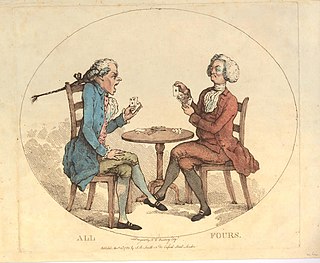
All fours is a traditional English card game, once popular in pubs and taverns as well as among the gentry, that flourished as a gambling game until the end of the 19th century. It is a trick-taking card game that was originally designed for two players, but developed variants for more players. According to Charles Cotton, the game originated in Kent, but spread to the whole of England and eventually abroad. It is the eponymous and earliest recorded game of a family that flourished most in 19th century North America and whose progeny include pitch, pedro and cinch, games that even competed with poker and euchre. Nowadays the original game is especially popular in Trinidad and Tobago, but regional variants have also survived in England. The game's "great mark of distinction" is that it gave the name 'jack' to the card previously known as the knave.

Bezique or bésigue is a 19th-century French melding and trick-taking card game for two players that came to Britain and is still played today. The game is derived from piquet, possibly via marriage (sixty-six) and briscan, with additional scoring features, notably the peculiar liaison of the Q♠ and J♦ that is also a feature of pinochle, Binokel, and similarly named games that vary by country.
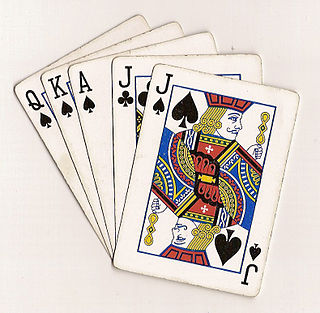
Euchre or eucre is a trick-taking card game commonly played in Australia, Canada, Great Britain, New Zealand, and the Midwestern United States. It is played with a deck of 24, 28, or 32 standard playing cards. There are normally four players, two on each team, although there are variations for two to nine players.
Marjapussi is a traditional Finnish trick taking game for 4 players playing in 2 partnerships and is one of the Mariage family, its key feature being that the trump suit is determined in the middle of the play by declaring a marriage. There are variants of Marjapussi for two and three players.

Polignac is a French 18th century trick-taking card game ancestral to Hearts and Black Maria. It is played by 3-6 players with a 32-card deck. It is sometimes played as a party game with the 52-card pack; however, it is better as a serious game for four, playing all against all. Other names for this game include Quatre Valets and Stay Away. Knaves is a variant and it is also similar to the Austrian and German games, Slobberhannes, Eichelobern and Grasobern.
Cinch, also known as Double Pedro or High Five, is an American trick-taking card game of the All Fours family derived from Auction Pitch via Pedro. Developed in Denver, Colorado in the 1880s, it was soon regarded as the most important member of the All Fours family in the USA, but went out of fashion with the rise of Auction Bridge. The game is primarily played by 4 players in fixed partnerships, but can also be played by 2–6 individual players.
Catch the Ten, also called Scots Whist or Scotch Whist, is an 18th-century point-trick, Ace-Ten card game which is recorded as being played only in Scotland, although evidence suggests a possible German origin. Unlike standard Whist, it is played with a pack of only 36 cards, the 5s and below being omitted. In the trump suit, the Jack is the highest card. Despite its alternative name, it has nothing to do with standard Whist.

Klaverjas or Klaverjassen is a Dutch, four player, trick-taking card game that uses a Piquet pack of 32 playing cards. It is closely related to the internationally popular card game of Klaberjass. Klaverjas is one of the most popular card games in the Netherlands, traditionally played in cafes and social clubs. The game offers a considerable level of complexity and depth. It has numerous variants, but its basic rules are universal.

The following is a glossary of terms used in card games. Besides the terms listed here, there are thousands of common and uncommon slang terms. Terms in this glossary should not be game-specific, but apply to a wide range of card games played with non-proprietary packs. It should not include terms solely related to casino or banking games. For glossaries that relate primarily to one game or family of similar games, see Game-specific glossaries.
Ristikontra or ristiklappi, sometimes translated as cross-clap, is a Finnish point-trick game for four players using a standard 52-card pack. Card suits do not play a role in this game, and there is no ranking order. A trick is won by the last player to play a card of the same rank as the card led.
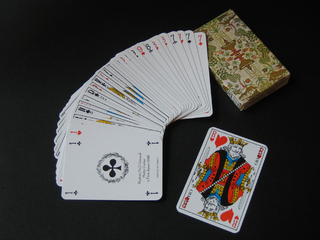
Brusquembille or Briscambille is an historical, French, 3-card trick-and-draw game for two to five players using a 32-card piquet pack. The game has variable trumps. Side-payments are made for keeping or winning aces and tens.
Elfern or Elfmandeln, is a very old, German and Austrian 6-card, no-trump, trick-and-draw game for two players using a 32-card, French-suited Piquet pack or German-suited Skat pack. The object is to win the majority of the 20 honours: the Ace, King, Queen, Jack and Ten in a Piquet pack or the Ace, King, Ober, Unter and Ten in a Skat pack. Elfern is at least 250 years old and a possible ancestor to the Marriage family of card games, yet it is still played by German children.
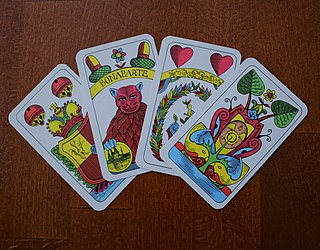
Bohemian Schneider is a card game for two people, which is played with a German-suited Skat pack of 32 cards. Because it is a simple trick-taking game, it is often played by older children and is recommended for age 8 upwards. It was probably developed in Bohemia and spread from there across the south German region and Austria. The game is sometimes called Bohemian Tailor, Schneider being German for "tailor".

Bräus is an old Swedish card game from the island of Gotland that differs from all others in that not all cards are actually playable. The game is descended from the oldest known card game in Europe, Karnöffel, a fact testified by its unusual card ranking and lack of a uniform trump suit.

Lusti-Kartl'n or Lusti-Kartn is a Bavarian trick-taking, card game for four players with an unusual rule for winning the tricks. Like the Czech game of Sedma, the winner of a trick is the last one to play a card of the same rank as the led card. Players form two teams of two and thus are able to smear their partner's tricks or play blanks if they think their opponents will win the trick. The only counters are the Aces and Tens, worth 10 points each, and there are 10 more points for the last trick. The aim is thus to win 50 or more points.
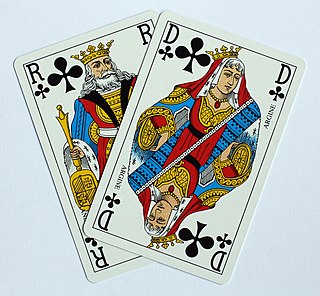
Briscan is an 18th-century, French Ace-Ten card game for two players played with a 32-card Piquet pack. It is a member of the Marriage group of games in which the 'marriage' of a King and Queen brings a bonus score, but Briscan takes this simple concept to extraordinary lengths.

Sedmice ("Seven") is a card game of the Sedma family played in the states of the former Yugoslavia. Like other games of this family, tricks are won by matching the led card in rank. In addition, the Sevens are wild, hence the name. In Croatia, the game is called Šuster.

Lorum or lórum is an old, Hungarian, compendium card game for 4 players. Although it is the ancestor of the French game, barbu, it is still played today. It uses a German-suited pack of 32 cards and comprises 8 individual contracts, each with different rules, each of which is played four times so that a session consists of a total of 32 individual games and lasts about 1½ hours.

Penneech or Peneech, sometimes called Penicth, is an unusual historical English card game for two players played with hands of seven cards. English point-trick games are rare anyway, but the unique feature of this game is that the trump suit changes with each trick. Parlett describes it as a "jolly little two-hander".
Cucumber is a north European card game of Swedish origin for two or more players. The goal of the game is to avoid taking the last trick. David Parlett describes it as a "delightful Baltic gambling game".















